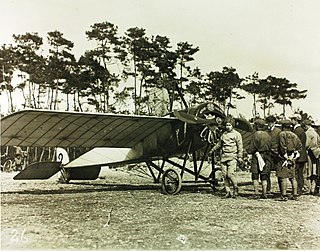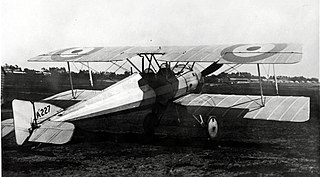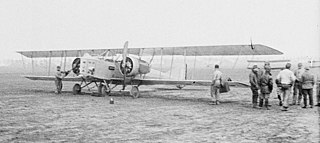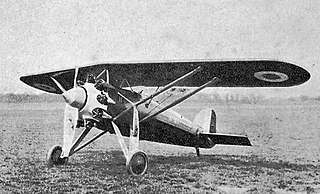
The Morane-Saulnier M.S.406 is a French fighter aircraft developed and manufactured by Morane-Saulnier starting in 1938. It was France's most numerous fighter during the Second World War and one of only two French designs to exceed 1,000 in number. At the beginning of the war, it was one of only two French-built aircraft capable of 400 km/h (250 mph) – the other being the Potez 630.

The Morane-Saulnier N, also known as the Morane-Saulnier Type N, was a French monoplane fighter aircraft of the First World War. Designed and manufactured by Morane-Saulnier, the Type N entered service in April 1915 with the Aéronautique Militaire designated as the MoS-5 C1. It also equipped four squadrons of the Royal Flying Corps, in which it was nicknamed the Bullet, and was operated in limited numbers by the 19th Squadron of the Imperial Russian Air Force.

The Morane-Saulnier L, or Morane-Saulnier Type L, or officially MoS-3, was a French parasol wing one or two-seat scout aeroplane of the First World War. The Type L became one of the first successful fighter aircraft when it was fitted with a single machine gun that fired through the arc of the propeller, which was protected by armoured deflector wedges. Its immediate effectiveness in this role launched an arms race in fighter development, and the Type L was swiftly rendered obsolete. The original Type L used wing warping for lateral control, but a later version designated Type LA was fitted with ailerons.

The Nieuport 12 was a French sesquiplane reconnaissance, fighter aircraft and trainer used by France, Russia, Great Britain and the United States during World War I. Later production examples were built as trainers and served widely until the late 1920s.

The Morane-Saulnier M.S.225 was a French fighter aircraft of the 1930s. It was produced in limited quantities to be used as a transitional aircraft between the last of the biplanes and the first monoplane fighters.

The Morane-Borel monoplane was an early French single-engine, single-seat aircraft. It was flown in several European air races.

The Morane-Saulnier MS.230 aircraft was the main elementary trainer for the French Armée de l'Air throughout the 1930s. Almost all French pilots flying for the Armée de l'Air at the outbreak of World War II had had their earliest flight training in this machine. It was the equivalent of the Stearman trainer in the United States air services and the de Havilland Tiger Moth in the British Royal Air Force.

The Morane-Saulnier G was a two-seat sport and racing monoplane produced in France before the First World War. It was a development of the racing monoplanes designed by Léon Morane and Raymond Saulnier after leaving Borel and, like its predecessors, was a wire-braced, shoulder-wing monoplane. Construction was of fabric-covered wood throughout, except for the undercarriage struts which were of steel tube.

The Morane-Saulnier AI was a French parasol-wing fighter aircraft produced by Morane-Saulnier during World War I.

The Morane-Saulnier Alcyon is a two or three-seat basic training monoplane designed and built in France by Morane-Saulnier.

The Morane-Saulnier Vanneau is a two-seat basic trainer built in France by Morane-Saulnier and ordered by the French Air Force.

The Morane-Saulnier I, also known as the Morane-Saulnier Type I was a French fighter of the 1910s. Essentially a modified Morane-Saulnier N, the Royal Flying Corps possessed a number of them in World War I.
The Morane-Saulnier V, also known as the Morane-Saulnier Type V was a French fighter of the 1910s.

The Morane-Saulnier AC, also known as Morane-Saulnier Type AC and MoS 23, was a French fighter of the 1910s.

The Morane-Saulnier AR was a trainer aircraft produced in France during and after the First World War.

The Morane-Saulnier BB was a military observation aircraft produced in France during World War I for use by Britain's Royal Flying Corps. It was a conventional single-bay biplane design with seating for the pilot and observer in tandem, open cockpits. The original order called for 150 aircraft powered by 110-hp Le Rhône 9J rotary engines, but shortages meant that most of the 94 aircraft eventually built were delivered with 80 hp Le Rhône 9C rotaries instead. A water-cooled Hispano-Suiza 8A engine was trialled as an alternative in the Type BH, but this remained experimental only. A production licence was sold to the Spanish company Compañía Española de Construcciones Aeronáuticas (CECA), which built twelve fitted with Hispano-Suiza engines in 1916.

The Morane-Saulnier H was an early aircraft first flown in France in the months immediately preceding the First World War; it was a single-seat derivative of the successful Morane-Saulnier G with a slightly reduced wingspan Like the Type G, it was a successful sporting and racing aircraft: examples serving with the French army were used in the opening phases of the war.

The Morane-Saulnier T was a French biplane reconnaissance aircraft in 1916 and produced in small numbers during World War I.

The Morane-Saulnier MS.138 was a military trainer aircraft produced in France in the late 1920s,

The Morane-Saulnier MS.224 was a prototype fighter plane built by Morane-Saulnier in the early 1930s.





















